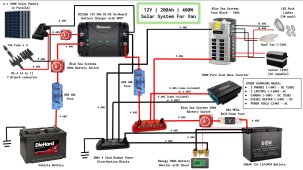The 'master' fuse at the SOC battery idealy should have a higher fault current withstand. The MEGA is only good for 2000 amps, better would be a MRBF fuse on a Blue Sea holder, directly on the battery post. ( MRBF rated at 10000 amps at 12v)
https://www.bluesea.com/products/5191/MRBF_Terminal_Fuse_Block_-_30_to_300A
With inverter efficiency the current will be higher than your calculation, and house loads also, fuse value 100/125 amps would be good. (note the SOK is rated for 100 amps continuous, a fault together with BMS failure could allow the battery to deliver 1000s of amps).
Fit your other fuses near or incorporated with the positive buss bar, 60A for the Renogy and 40A for the fuseblock feed.
Wiring error, all battery negative should pass the shunt, remove the connection from the battery negative to buss bar.
Once operational you will have a better idea of managing power use. You may need some care using the inverter at full power together with all house 12v loads as you could exceed the 100 amps limit on the battery.
Investigate USB and laptop charging via 12v power converters, fed via fuses in the 12v fuseblock . This will be more efficient than using the inverter.
Mike




